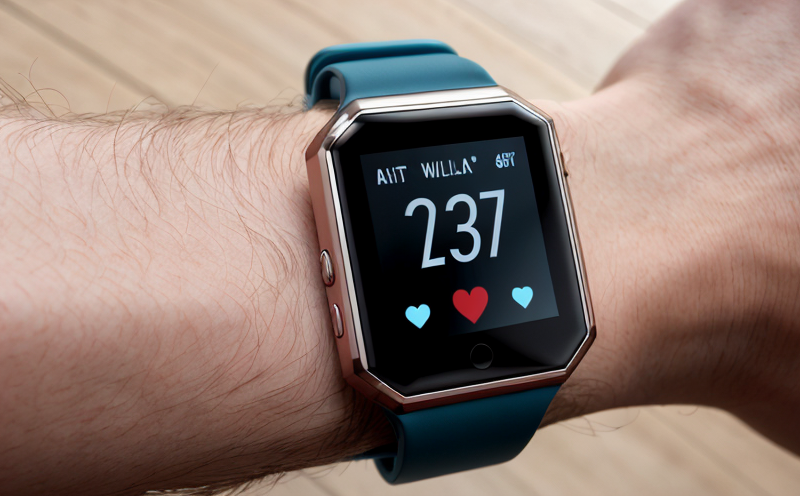IEC 60068-2-11 Salt Mist Corrosion Testing for Wearable Devices
The International Electrotechnical Commission (IEC) standard IEC 60068-2-11 specifies the method of testing electronic devices and components to evaluate their resistance to salt mist corrosion. This test is particularly relevant for wearable devices, which are increasingly used in healthcare, fitness tracking, and other sectors where environmental exposure can significantly impact device performance.
Wearable devices such as smartwatches, activity trackers, and medical wearables must withstand various environmental conditions, including humidity, temperature fluctuations, and contamination. Salt mist corrosion is one of the most common forms of degradation that electronic components face in harsh environments. The IEC 60068-2-11 test ensures that wearable devices can maintain their functionality and reliability under these challenging conditions.
The test involves exposing specimens to a controlled atmosphere containing sodium chloride (NaCl) aerosol, which simulates salt-laden air found in coastal areas or industrial environments. The apparatus used for this testing typically includes a mist generator capable of producing the specified concentration and flow rate of salt particles. The duration of exposure can vary based on the specific requirements outlined in IEC 60068-2-11.
After the test, engineers assess the specimens to determine if there has been any degradation or failure due to corrosion. Acceptance criteria are defined in accordance with the standard and may include visual inspections for signs of rusting or other forms of corrosion, as well as electrical resistance measurements to ensure that the device functions correctly after exposure.
By adhering to IEC 60068-2-11, manufacturers can ensure that their wearable devices meet international quality standards and are suitable for use in various environments. This testing process is crucial for protecting both consumer safety and the integrity of medical-grade wearables used in healthcare settings.
Scope and Methodology
The scope of IEC 60068-2-11 covers the testing procedures for evaluating the resistance to salt mist corrosion of electrical and electronic equipment. The methodology involves subjecting specimens to a controlled atmosphere containing sodium chloride aerosol, with parameters such as temperature, humidity, and flow rate carefully regulated.
The test procedure begins by preparing the specimen according to the standard's specifications. This includes cleaning the device to remove any surface contaminants that could affect the results of the test. The specimen is then placed in a chamber where it undergoes exposure to the salt mist atmosphere for a specified duration. During this time, various parameters are monitored and recorded.
After the exposure period, the specimens are inspected visually for signs of corrosion, such as rusting or other discolorations. Additionally, electrical resistance measurements may be taken to assess any changes in performance due to the test environment. The results of these inspections are compared against acceptance criteria defined by IEC 60068-2-11 to determine if the device meets the required standards.
The methodology ensures that all relevant aspects of salt mist corrosion testing are addressed, providing a comprehensive evaluation of the specimen's ability to withstand harsh environmental conditions. Compliance with this standard is essential for ensuring product reliability and safety across diverse applications.
Benefits
Compliance with IEC 60068-2-11 offers numerous benefits, including enhanced product quality, improved consumer trust, and increased market competitiveness. By ensuring that wearable devices meet rigorous international standards, manufacturers can gain a competitive edge in the global market.
- Enhanced Product Quality: Adherence to IEC 60068-2-11 guarantees that products are robust enough to perform reliably under extreme conditions, reducing the risk of failures and recalls.
- Improved Consumer Trust: Consumers are more likely to trust brands that demonstrate a commitment to high-quality standards, leading to increased customer satisfaction and loyalty.
- Increased Market Competitiveness: Meeting international standards can open doors to new markets and partnerships, expanding the reach of your products globally.
In addition to these benefits, compliance with IEC 60068-2-11 also helps companies stay ahead of regulatory requirements, ensuring that they are prepared for future changes in industry standards. This foresight allows businesses to avoid costly delays and penalties associated with non-compliance.
Use Cases and Application Examples
| Use Case | Description |
|---|---|
| Smartwatches | Salt mist corrosion testing ensures that smartwatches continue to function accurately even in areas with high humidity or industrial environments. |
| Activity Trackers | Compliance helps protect the integrity of activity trackers used by consumers and athletes, ensuring accurate data collection regardless of environmental conditions. |
| Medical Wearables | The testing ensures that medical wearables remain reliable in hospital environments, reducing the risk of malfunctions during critical patient care. |
| IoT Devices | Testing confirms that IoT devices can operate effectively in diverse and challenging environments, enhancing overall network reliability. |
- Sporting Goods: Ensures the durability of wearable sports equipment used by athletes in various conditions.
- Outdoor Gear: Guarantees that outdoor gear is robust enough to withstand harsh weather and environmental factors.
The results of IEC 60068-2-11 testing provide valuable insights into how well a device can perform in real-world scenarios. This information is crucial for manufacturers, quality managers, and R&D engineers who rely on accurate data to improve product design and performance.





